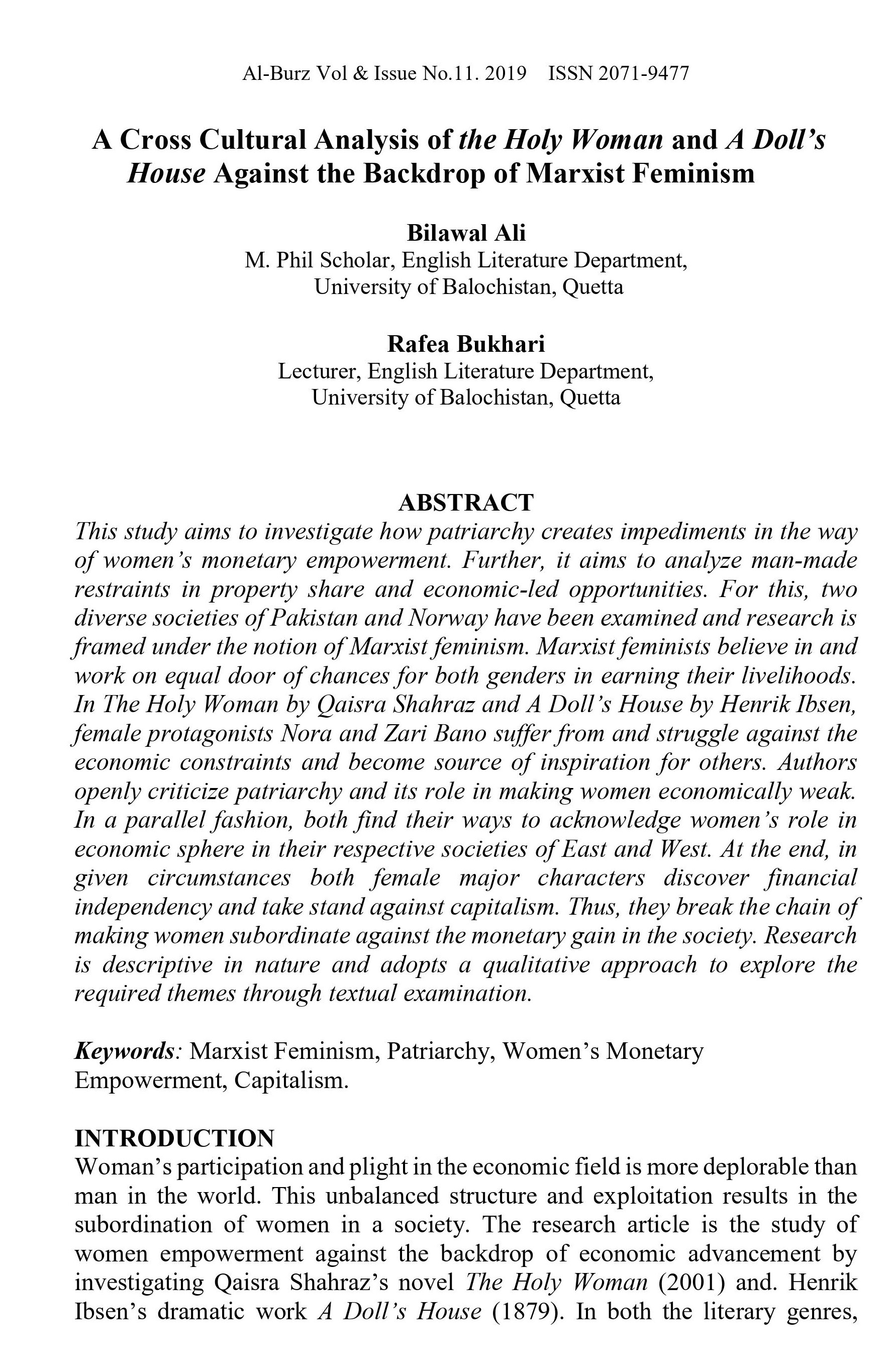A Cross Cultural Analysis of The Holy Woman And A Doll’s House Against The Backdrop Of Marxist Feminism
DOI:
https://doi.org/10.54781/abz.v11i1.54Keywords:
Marxist Feminism, Patriarchy, Women’s Monetary Empowerment, CapitalismAbstract
This study aims to investigate how patriarchy creates impediments in the way of women’s monetary empowerment. Further, it aims to analyze man-made restraints in property share and economic-led opportunities. For this, two diverse societies of Pakistan and Norway have been examined and research is framed under the notion of Marxist feminism. Marxist feminists believe in and work on equal door of chances for both genders in earning their livelihoods. In The Holy Woman by Qaisra Shahraz and A Doll’s House by Henrik Ibsen, female protagonists Nora and Zari Bano suffer from and struggle against the economic constraints and become source of inspiration for others. Authors openly criticize patriarchy and its role in making women economically weak. In a parallel fashion, both find their ways to acknowledge women’s role in economic sphere in their respective societies of East and West. At the end, in given circumstances both female major characters discover financial independency and take stand against capitalism. Thus, they break the chain of making women subordinate against the monetary gain in the society. Research is descriptive in nature and adopts a qualitative approach to explore the required themes through textual examination.
References
Baig, S. [AYAN Television]. (2010, April 12). Qaisra Shahraz Interview [Video file].
Retrieved from https://www.youtube.com.
Bangulzai, A. L. (2014). Brahui Zuban o Adab na Shondari Ti Risala Wa Jarahid hatha Bashk. Pakistan: Brahui Academy.
Chanter, T. (2006). Gender: Key concepts in philosophy. London: Continuum International Publishing Group.
Hassan, Y. (1995). The Haven Becomes Hell-A Study of Domestic Violence in Pakistan, Special Bulletin August. Lahore: Shirkat Gah & WLUML.
Ibsen, H. (1879). A Doll’s House. trans by William Archer. (1st ed.). Dhaka: Mim Printers
Jadoon, A. (2015). A Feminist Turned Holy Woman: Image of the Veiled Muslim Woman in Qaisra Shahraz’s Novel The Holy Woman. NUML Journal of Critical Inquiry, 13(I), ISSN 2222-5706.
Khan, H. (2019). A Feminist Critical Discourse Analysis of Qaisra Shahraz's The Holy Woman in the Backdrop of Sublaternity. International Journal of English Linguistics, Vol. 9(V).
Kumari, V. N. (2017). Women Perspective in Henrik Ibsen’s A Doll’s House. An International Journal in English, Vol.8(IV).
Mazhar, U. (2003). Retrieved May 6, 2016 'Married to the Quran'. The Friday times of Pakistan. Retrieved from http://www.islamawarness.net.
Millett, Kate. 1970. Sexual Politics. New York: Doubleday.
Saigol, R. (2016). Feminism and the Women’s Movement in Pakistan: Actors, Debates and Strategies. Islamabad: Friedrich-Ebert-Stiftung.
Shahraz, Q. (2001). The Holy Woman. Islamabad: BlackAmber Books Limited.
Uddin, N. (2013). Nora in Ibsen’s A Doll’s House and Komol in Saratchandra’s Shesh Proshno: A comparative study from feminist perspective. Academic Journals, 4(XII), 292-296.
Weeks, K. (2011). The Problem with Work. Durham and London: Duke University Press.

Downloads
Published
How to Cite
Issue
Section
License
Copyright (c) 2019 Authors who publish with Al-Burz journal agree to the following terms: 1. Authors retain copyright and grant the journal right of first publication with the work simultaneously licensed under a Creative Commons Attribution (CC-BY) License that allows others to share the work with an acknowledgement of the work's authorship and initial publication in this journal. 2. Authors are able to enter into separate, additional contractual arrangements for the nonexclusive distribution of the journal's published version of the work (e.g., post it to an institutional repository or publish it in a book), with an acknowledgement of its initial publication in this journal.Alburz has licensed under a CC Attribution-NonCommercial-ShareAlike 4.0



